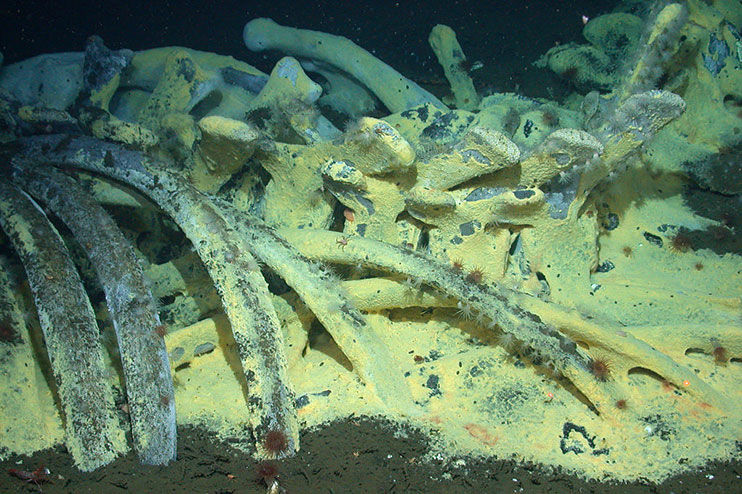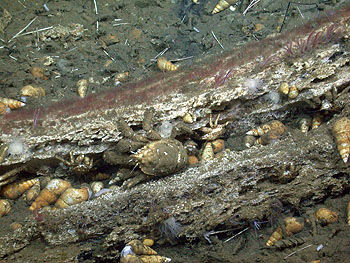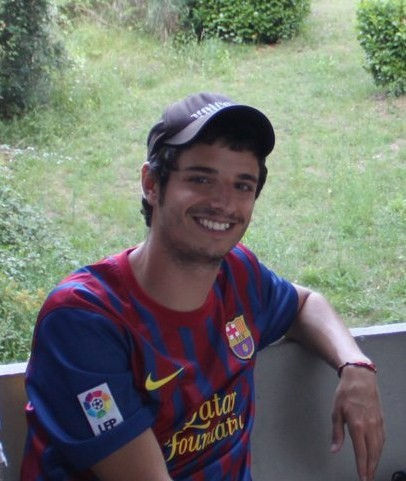The extraordinary life of whale carcasses in the deep ocean
- Bate-papo com Netuno
- 8 de nov. de 2017
- 6 min de leitura
By Joan Manel Alfaro Lucas
Translated by: Lídia Paes Leme
Edited by: Katy Shoemaker
This story starts in 1987, when, during an oceanographic expedition lead by Dr. Craig Smith (University of Hawaii), the research robot Alvin found a whale carcass on the ocean floor in Santa Catalina Bay, California, 1240 meters deep (Smith et al., 1989). This discovery reinforced an idea that had been suggested before, that even though whale deaths are common in coastal zones, many die in spots far away from beaches and sink down to the depths of the ocean.
The deep ocean covers 63% of the planet's surface and is considered the biggest biome on Earth. It is unique and extreme due to its low temperatures, high pressure, and darkness (light doesn't penetrate more than 200 meters below surface, where the deep ocean starts). The absence of light makes organic matter production via photosynthesis impossible. Because of this, the deep ocean ecosystem is limited in food sources and depends almost exclusively on the sinking of organic matter produced in the surface waters. In the vast, cold, dark deserts of the deep ocean known as the abyssal plains, the few organisms that survive there filter water and sediments to take in the little organic matter that sinks down from the surface.
So now what about that Californian whale that Dr. Smith found? The carcass was completely missing meat, and other indicators suggested the whale carcass had been there for several years. However, the skeleton and the sediment around it were bursting with life! There were worms, snails, gastropods, dense mats of bacteria, and bivalves such as clams and mussels. The carcass was a real oasis of life in the deep desert of the bay. The scientists began to understand that, for an environment so poor in nutrients, the arrival of a whale carcass is an extraordinary event.
Whales are the largest animals that inhabit Earth. The blue whale can be 30 meters (~100 feet) long and weigh 120 kilotons and is the largest animal that has ever existed on our planet. To the desert depths of the ocean floor, their carcasses are the biggest source of organic matter that arrives from the surface. One carcass from a 40-kiloton whale is the equivalent of 2000 years worth of organic matter falling down at once!

Some of the organisms found for the first time on the carcass by Dr. Smith became much more interesting when identified. For example, some bivalve species found there are known to have symbiotic relationships with chemosynthetic bacteria. Those mussels feed on the matter produced by the bacteria, a process similar to what shallow water corals have with photosynthetic organisms. As it turns out, the dense bacterial mats found on the carcass were of that kind of bacteria.
Similar to vegetables in the terrestrial environment, these chemosythetic bacteria form the base of the food chain in the deep ocean. Chemosynthetic communities feed on organic compounds, some of which can be abundant on the sea floor. This is the case in hydrothermal vents, which form in parts of the floor where volcanic activity is elevated and hydrocarbons flow from underground reservoirs (post about hydrothermal vents here). The bivalve species associated with the whale carcass were discovered for the first time at cold hydrothermal vents! These similarities suggested that the whale carcass acts as a trampoline for the common habitants of different chemosynthetic communities to disperse, as they are usually separated by distances larger than can be reached by larval dispersion (Smith et al., 1989).
This discovery, other than being revolutionary for the ecology of chemosynthetic communities, led several groups of scientists to research more about these ecosystems. Rather than looking for a carcass on the vast ocean floor (a real needle in a haystack situation), scientists started to sink dead whale carcasses with weights. They were able to sink them in a determined spot where they could sample whenever needed. After these experiments, scientists began to understand that not only chemosynthetic communities developed in the carcasses, but also there were extremely diverse and abundant communities that explored the carcasses in amazing ways… for almost a century!

The whale carcasses develop mostly three ecological successive states, meaning three communities can be distinguished throughout time (Smith et al., 2015). The first stage starts with the arrival of the carcass in the bottom and includes the mobile necrophagous organisms. Hundreds of animals, like hagfish, drill the meat while sharks bite big chunks off. These communities, similar to vultures in a savanna, remove several dozen kilograms by day and can consume all the meat in up to two years, depending on the size of the carcass.

The second stage involves the enrichment of opportunists and can also last up to two years. During this period, high densities of worms, crustaceans, and other invertebrates colonize the sediment around the skeleton that was exposed after the flesh was consumed. These invertebrates feed directly on the left over fat and meat left behind by the necrophagous organisms, as well as the bones, which are rich in protein and fat.
The last stage, the one Dr. Smith's whale was in when he found it, is the sulphophilic stage. Some microorganisms are able to penetrate the dense bone structure and access the big quantities of fat remaining in the interior of the bones. These organisms use the sulfur dissolved in water to digest the fat, creating inorganic compounds as secondary products. Similar process can also occur in the surrounding sediment, which was impacted by the organic matter of the carcass. This creates enough of a flux to develop a community based on chemosynthesis. This is the longest stage, lasting up to 80 years.
The discoveries around whale carcasses don't stop there. Since 1987, when Dr. Smith studied the first deep ocean carcass, 129 new species have been discovered, many of them only found in those communities. The most surprising one was discovered in 2002, when Osedax, a new kind of worm, was discovered in Monterey Canyon, California, at 2891 meters deep (Rousse et al., 2004). The species in this genre are sessile and don't have a mouth nor anus, nor any kind of digestive system, yet they feed on whale bones!
Osedax have a structure called a root, which helps to answer the multiple mysteries surrounding these organisms. This structure, with globular ramifications, fixes the organism to the bones and has pumps that acidify the bone matter. The “soup” produced in this process is sent up through the root into internal structures, where endosymbiotic bacteria are responsible for digestion. These worms are capable of completely decaying a whole juvenile skeleton (containing less calcified bone or fat then adults) in one decade. Impressive, no? Just wait…
All of these structures and endosymbionts only apply to female Osedax. The males are microscopic dwarves that live inside of the females, as simple sperm reservoirs. The Osedax larvae that are found on a skeleton develop as female, but if they find other females, they can get absorbed and develop as pedomorphic males, meaning they only develop sexually and not fully morphologically, retaining larval characteristics. Each female can absorb hundreds of males, which is believed to be a successful reproductive strategy.

Organisms like Osedax show that whale carcasses are not only an oasis of life in the deep ocean, but also showcase uniquely evolved and specialized life forms. However, are the carcasses sustaining similar communities in all of the ocean basins? Or, like in hydrothermal vents, does each basin sustain communities with different evolutionary histories? This kind of question is still very hard to answer because practically all of the natural and placed carcasses have been studied in the Northern Pacific.
Only in 2010 was a natural carcass discovered on the seafloor near Antarctica, and, more recently in 2013, in the Southwest Atlantic off of the Brazilian coast. The latter is currently being studied by Brazilian and Japanese researchers, and is the topic of my Master's project at the University of São Paulo. This represents the first whale sink community to be studied in all of the deep Atlantic. The results of the research are beginning to emerge, reinforcing some previous hypotheses and explaining even more about the functioning of various ecological processes.
Many questions are still to be answered, and many more will be generated in the future. These extraordinary communities, not known 30 years ago, are a bottomless source of surprises!
References, links and videos:
Smith, C.R., Kukert, H., Wheatcroft, R.A, Jumars, P.A., Deming, J.W. (1989) Vent fauna on whale remais. Nature, 341. Pp 27-28.
Rouse, G.W., Goffredi, S.K., Vrijenhoek, R.C. (2004) Osedax: Bone-Eating Marine Worms with Dwarf Males. Science, 305.Pp 668-671.
Smith, C.R., Glover, A.G., Treude, T., Higgs, N.D., Amon, D.J. (2015) Whale-Fall Ecosystems: Recent Insights into Ecology, Paleoecology, and Evolution. Annual Review of Marine Science, 7. Pp 571-596.
About Joan Manel Alfaro Lucas:

A biologist from the Universitat Autonoma de Barcelona, Barcelona, I did a one year internship at the Federal University of Minas Gerais, which allowed me, among other things, to get to know Brazil and learn Portuguese. I'm passionate about the ecology of deep ocean communities, especially chemosynthetic ones. I did a Masters at the Oceanographic Institute of the University of São Paulo, where I had the opportunity to study the first whale carcass discovered in the deep Atlantic ocean. Other than that, I have experience in oceanographic cruises, sailed 2800 nautical miles across the southwest Atlantic, sampling, sorting and identifying benthic invertebrates, stable isotope analysis, and using the R language in ecological research.

Comments